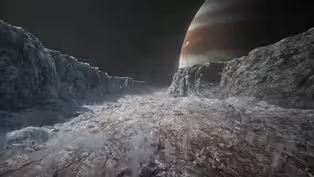
Why Do Comets Have Tails?
Clip: Season 51 Episode 12 | 55sVideo has Closed Captions
As comets cross the invisible boundary known as the ice line, their ice starts turning into gas.
Worlds that exist close to the warmth of the sun, like the rocky worlds of Mars, Earth and our moon, have relatively little ice, because they lie inside what is known as the ice line.
Problems playing video? | Closed Captioning Feedback
Problems playing video? | Closed Captioning Feedback
National Corporate funding for NOVA is provided by Carlisle Companies and Viking Cruises. Major funding for NOVA is provided by the NOVA Science Trust, the Corporation for Public Broadcasting, and PBS viewers.

Why Do Comets Have Tails?
Clip: Season 51 Episode 12 | 55sVideo has Closed Captions
Worlds that exist close to the warmth of the sun, like the rocky worlds of Mars, Earth and our moon, have relatively little ice, because they lie inside what is known as the ice line.
Problems playing video? | Closed Captioning Feedback
How to Watch NOVA
NOVA is available to stream on pbs.org and the free PBS App, available on iPhone, Apple TV, Android TV, Android smartphones, Amazon Fire TV, Amazon Fire Tablet, Roku, Samsung Smart TV, and Vizio.
Buy Now

NOVA Labs
NOVA Labs is a free digital platform that engages teens and lifelong learners in games and interactives that foster authentic scientific exploration. Participants take part in real-world investigations by visualizing, analyzing, and playing with the same data that scientists use.Providing Support for PBS.org
Learn Moreabout PBS online sponsorship- You can't see the ice line, but you can see its effects.
- When small bodies that are primarily composed of ice cross inside of the ice line, the ice within them begins to vaporize.
- [Narrator] Sometimes icy rocks are ejected from the frigid outer regions of the solar system and pulled towards the sun.
These are known as comets.
- Comets are basically dirty snowballs, mostly water, ice, with a little bit of dust.
And as they come into the inner solar system, they get heated up by the sun.
- [Narrator] As comets cross this invisible ice line, their ice starts turning into gas.
- And that's what forms these long tails that we can see when you look at a comet, and those tails stream away from the sun as the comet moves in towards it.
- [Narrator] Inside the ice line, ice is rare, but there are places where it can hang on.
(mysterious music)
Solar System: Icy Worlds Preview
Video has Closed Captions
Preview: S51 Ep12 | 30s | Visit strange, frozen worlds to discover the bizarre ice that forms beyond Earth. (30s)
This Moon May Have the Ingredients for Life
Video has Closed Captions
Clip: S51 Ep12 | 2m 14s | The ocean beneath Europa’s icy shell might be an ideal environment for life. (2m 14s)
Providing Support for PBS.org
Learn Moreabout PBS online sponsorship
- Science and Nature

Capturing the splendor of the natural world, from the African plains to the Antarctic ice.













Support for PBS provided by:
National Corporate funding for NOVA is provided by Carlisle Companies and Viking Cruises. Major funding for NOVA is provided by the NOVA Science Trust, the Corporation for Public Broadcasting, and PBS viewers.




